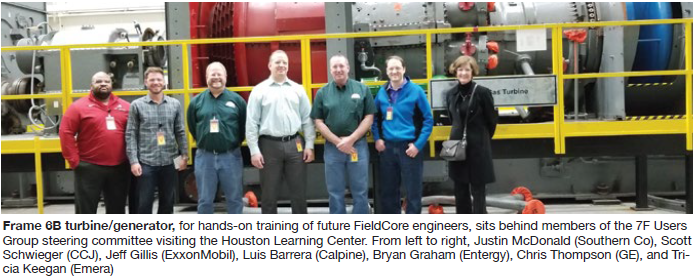Members of the 7F Users Group steering committee recently visited GE’s Houston Learning Center (HLC) to become acquainted with the new training facility and to discuss with the OEM the needs, expectations, and concerns of owner/operators to ensure improved field-service outcomes. CCJ Senior Editor Scott Schwieger was an invited observer.
Background. In 2014, GE Power Services Training acquired and repurposed the Houston Service Center on Wallisville Road. The 15-acre campus has been revitalized to accommodate field-engineer, craft, and customer training in aeroderivatives, controls, excitation, gas and steam turbines, generators, installation and commissioning, and inspection and life-extension services.
HLC is designed to accommodate up to 400 students per day in its three main buildings, ranging from 20,000 to 45,000 ft2. Building One houses 9E, 7E, 7F, and D11 heavy-duty equipment in its bays, as well as state-of-the-art classrooms and distance-learning suites. Building Two is occupied by FieldCore—GE’s independent industrial field-services company—and dedicated to craft training. Building Three has areas focused on aeroderivatives, controls, and excitation training.

Strength in numbers. The 7F Users Group steering committee works diligently to support owner/operators by fostering a healthy relationship with the OEM. Through their deck-plates feedback, and the open ears of the training staff, the entire fleet will benefit.
Jim Rosen, GE Power’s technical training manager, opened the floor for questions/comments after providing an overview of the facility and available training modules. The discussion was meaningful given the five steering-committee participants (photo) combined have well over 100 years of gas-turbine experience; plus, two are graduates of the GE Field Engineer program.
Suggestions of areas for program improvement and streamlining included the following:
- More emphasis on reading manuals, finding drawings, and familiarity with parts/part numbers.
- Increased focus on people skills and leadership training to improve face-to-face customer and crew relations.
- Acceptance and understanding of the customer’s safety culture.
- Cost tracking and financial understanding with respect to change orders.
- Openness in communicating escalating issues to site management in a timely manner.
- Use of shared, consistent forms for field reports—such as shift-turnover protocol and daily outage updates.
- Sharing level designation (and what that means) and training courses of study for all field engineers onsite.
- Struggles with turnover package in outage, as technical field advisors often take a back seat to experienced craft workers.
- More timely responses for reasonable customer inquiries.
Response. The concerns have not gone unnoticed and the OEM already has instituted modifications to the training program to address field issues. All engineers in customer-facing positions will have more training in communications and writing. A new app in development, called “Field Vision,” is designed to standardize checklists that are easily shareable between organizations. GE is working on a “level” system of qualification with full sign-off requirements to be certified for a certain level of training, which can be more easily communicated to customer. And, finally, the “Operations Excellence Quality” group is being reinvigorated for enhanced QA/QC and rigorous training foundations.
Users are encouraged to participate in more in-depth discussion on training, outage management, and safety at the upcoming annual conference. CCJ


